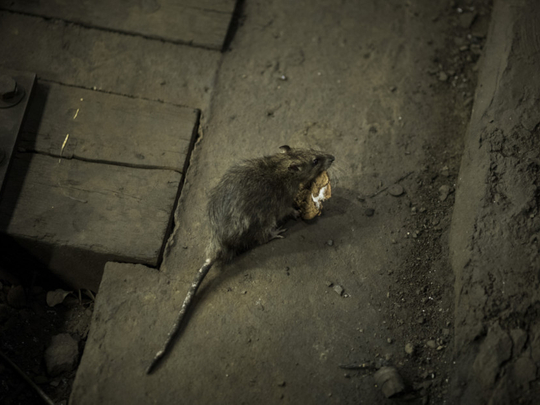
Paris: It all started with a video shot late last year on the banks of the Seine, between the Musee d’Orsay and Pont Royal bridge in the French capital.
The video, which has gone viral around the world since first being posted by the daily Le Parisien, shows garbage collectors discovering with horror dozens of hungry rats crawling at the bottom of a garbage bin.
The footage kicked off a controversy over the “proliferation” of rats in Paris, and the deplorable working conditions of the city’s garbage collectors.
Growing population
There are now between 4 and 6 million rats in Paris, according to different sources. “But in reality, it’s impossible to know precisely how many of them there are,” says Georges Salines, who heads of the city’s environmental health service.
“Their number varies according to the amount of food available and their living conditions.
“Rats are complex social animals that can stabilise their population according to vital resources. That’s why I think it’s wrong to talk about a proliferation of rats in our city. Despite the appearances, their population remains stable.”
And yet, for several months now, in the early morning or as soon as night falls, alone or in small groups, rats seems to be more abundant and less and less fearful.
They leave their holes in search of food, sometimes in front of passers-by.
They gather around garbage cans, criss-cross grassy areas in the city’s parks and scramble around the Champs-Elyses and in the streets where open-air markets are held.
Rodent flow
They can even be seen in the square in front of the Notre Dame Cathedral, much to the dismay of tourists, who much prefer the friendly cartoon rats of Disney’s Ratatouille to the real flesh and blood variety.
The swollen Seine, bursting its banks after weeks of rain, has made things worse. “Their burrows on the river banks and in the sewers were flooded and many colonies were forced to migrate elsewhere.
But it doesn’t mean they’ve invaded Paris,” says Pierre Falgayrac, a rat specialist and author of several books.
Just because the rats or more visible, in other words, doesn’t mean they’re more numerous.
Hungry and homeless
“We should even expect to see increased mortality and reduced reproduction in the near future,” Falgayrac predicts. “What’s more, major construction products in Paris — the expansion of the tramway, for example — keep driving them out of their holes, and their population is constantly weakened.
This, in my opinion, could explain the sporadic concentrations of hungry and unusually aggressive rodents.”
Even before the now-famous rat video made the rounds, mayors in some of the city’s arrondissements chided what they called a lack of action on the issue and called for a Paris-wide crackdown on the rodents.
Adding to the sense of concern is a study carried out by INRA, VetAgro Sup and the Pasteur Institute suggesting that some rats have become “genetically resistant” to the poisons used to control their population.
Researchers believe that by regularly consuming the anticoagulant products, but in small doses, rats are gradually developing an immunity.
“Above all, city authorities should eliminate rats from future construction sites before work actually begins. That way they prevent the rats from moving elsewhere,” says Falgayrac.
The specialist also advocates filling up some sewers with concrete, particularly ones that are in areas with lots of restaurants, and requiring restaurateurs to clean up their terraces in the evening, before closing, rather than in the morning.
Bring on the corn starch!
The specialist says that under normal circumstances, sewer rats are quiet and timid animals that spend the most of their time hidden and only come out of their burrows to eat and drink. “The real problem is the risk that they could provoke electrical accidents,” Falgayrac explains.
“European standards now require that the plastic sheathing traditionally used to cover electric cables be replaced with materials made from corn starch, which rodents love. The situation ought to be taken very seriously.”















